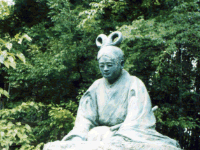 The origin of Hotoji temple dates back to Gokurakuji temple which was built by the Fujiwara clan in the Heian period (from 794 AD).
Nissho was the successor of Nichiren, who was the founder of the Nichren sect. Nissho was banished from Kyoto during his missionary
work in 1307 AD. At that time, Nissho debated for three days and nights on various religious issues with Ryoukei who was then the
chief priest of the Gokurakuji temple. At the end, Nissho defeated Ryoukei. Nissho transformed Gokurakuji temple into the Hokke
sect school. Nissho passed away in 1342 AD, and was cremated here according to his will.
The remains of Nichiren and Nichiro were also enshrined in this temple and this area has since been called the West-Minobu or
the sacred mountain in Tatsumi. Nichigin, who was the pupil of Nissho, succeeded as the 8th chief priest and began the
reconstruction of several ruined temples in 1590 AD.
The main hall (now, an important cultural asset property) was completed in 1608 using the surplus materials donated to the
building of the Kyoto Great Buddha Hall. At that time, this temple's name was changed from "Kakurininnjyoujyakuji" to "Hotoji" temple.
The origin of Hotoji temple dates back to Gokurakuji temple which was built by the Fujiwara clan in the Heian period (from 794 AD).
Nissho was the successor of Nichiren, who was the founder of the Nichren sect. Nissho was banished from Kyoto during his missionary
work in 1307 AD. At that time, Nissho debated for three days and nights on various religious issues with Ryoukei who was then the
chief priest of the Gokurakuji temple. At the end, Nissho defeated Ryoukei. Nissho transformed Gokurakuji temple into the Hokke
sect school. Nissho passed away in 1342 AD, and was cremated here according to his will.
The remains of Nichiren and Nichiro were also enshrined in this temple and this area has since been called the West-Minobu or
the sacred mountain in Tatsumi. Nichigin, who was the pupil of Nissho, succeeded as the 8th chief priest and began the
reconstruction of several ruined temples in 1590 AD.
The main hall (now, an important cultural asset property) was completed in 1608 using the surplus materials donated to the
building of the Kyoto Great Buddha Hall. At that time, this temple's name was changed from "Kakurininnjyoujyakuji" to "Hotoji" temple.
 The Deva King's gate was built in 1711 AD. The Deva on the right is "Misshaku Kongou" and on the left is "Naraen Kongou".
When you walk up the road leading to the north side of the Shrine and after passing through the Sichimensha, you will
reach an easy hiking trail with a good view of the Fukakusa graveyard.
The Deva King's gate was built in 1711 AD. The Deva on the right is "Misshaku Kongou" and on the left is "Naraen Kongou".
When you walk up the road leading to the north side of the Shrine and after passing through the Sichimensha, you will
reach an easy hiking trail with a good view of the Fukakusa graveyard.
|
|
|
|
|
|
Enlargemen | |
| Thanks to Mr. D.M. | |